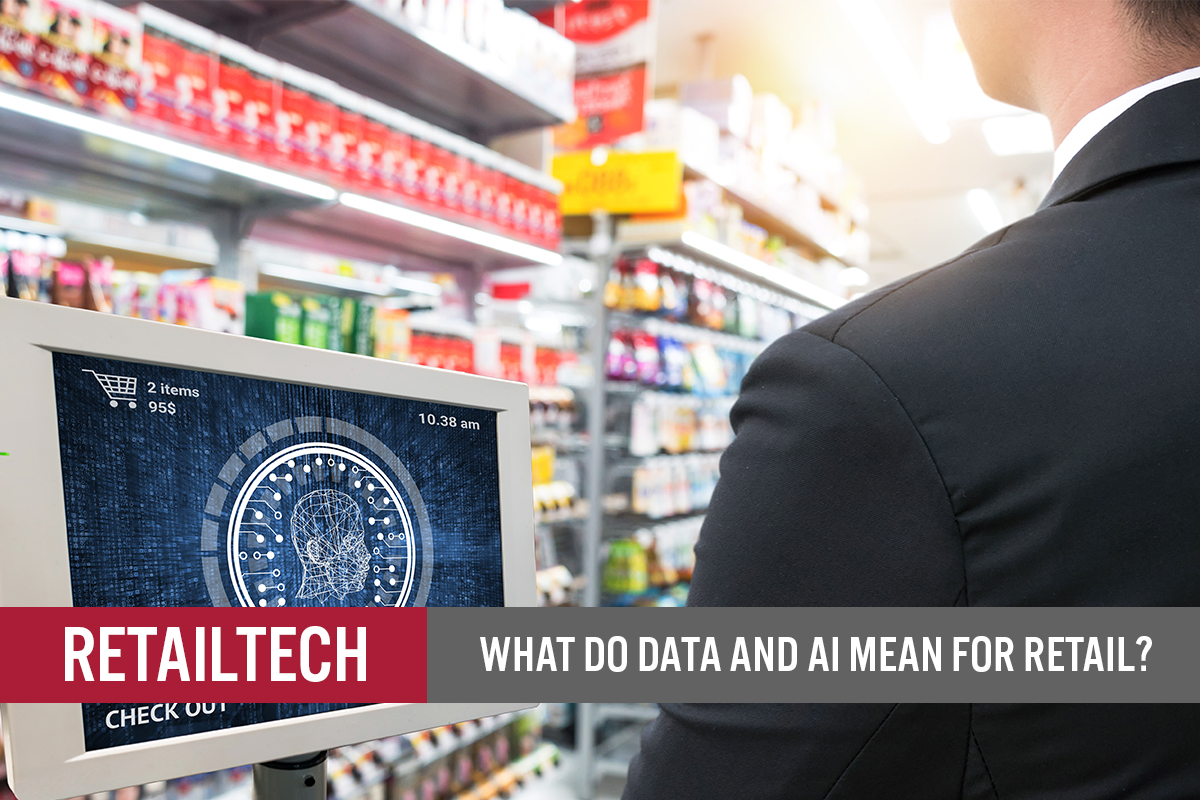
Nitheesh NH
What’s the Story?
Data should be the lifeblood of retail since it carries essential information that retailers can use to get to know and engage their customers better, and remove friction from shopping, checkout and delivery experiences. Much of this data is unfortunately stored in unconnected silos and retailers are, therefore, missing out on key data insights. As part of our RetailTech series, we discuss the strengths of AI for leveraging different data types across different locations to generate actionable insights for retailers.Why It Matters
The retail industry is steadily becoming more competitive, which is largely due to:- The steady encroachment of e-commerce, which is led by data-centric e-commerce companies that face lower entry barriers
- Major technology investments among large retailers, particularly mass marketers such as Target and Walmart, who are making and benefiting from cloud computing and AI
- Global competition in retail due to the advent of cross-border shipping and the emergence of technology-fueled e-commerce companies
- Wide swings in category demand during the pandemic, which favors retailers with advanced supply-chain management
- An increasingly flexible customer base, with little tolerance for friction and low switching costs among online platforms
Data and AI in Retail: A Deep Dive
This report discusses the challenges that retailers face with regard to managing and drawing actionable insights from their data. We discuss tools that retailers can use and provide cases where retailers are using data and AI to enhance their businesses. We use Coresight Research’s proprietary CORE framework to categorize and explain the benefits of AI for retailers. A Retailer-Centric vs. Customer-Centric Market For decades, retail has centered on the physical store, with additional channels such as online commerce, social media and smartphone apps essentially “bolted on” to the existing brick-and-mortar model, as depicted in Figure 1. This model is known as omnichannel retail—referring to the connected, but still siloed, channels that the consumer uses to communicate with the retailer. Figure 1. The Traditional Retailer-Centric Omnichannel Retail Model [caption id="attachment_124570" align="aligncenter" width="380"] Source: Coresight Research[/caption]
Retailers that have emerged more recently than their long-standing traditional counterparts, such as Alibaba, Amazon and JD.com, have looked to reconfigure retail by putting the consumer at the center. Whereas the retailer occupies the key location in Figure 1, new retail models center on the customer. Alibaba refers to this model as New Retail and it is known as Boundaryless Retail by JD.com.
Figure 2. The New, Consumer-Centric Retail Model
[caption id="attachment_124571" align="aligncenter" width="380"]
Source: Coresight Research[/caption]
Retailers that have emerged more recently than their long-standing traditional counterparts, such as Alibaba, Amazon and JD.com, have looked to reconfigure retail by putting the consumer at the center. Whereas the retailer occupies the key location in Figure 1, new retail models center on the customer. Alibaba refers to this model as New Retail and it is known as Boundaryless Retail by JD.com.
Figure 2. The New, Consumer-Centric Retail Model
[caption id="attachment_124571" align="aligncenter" width="380"]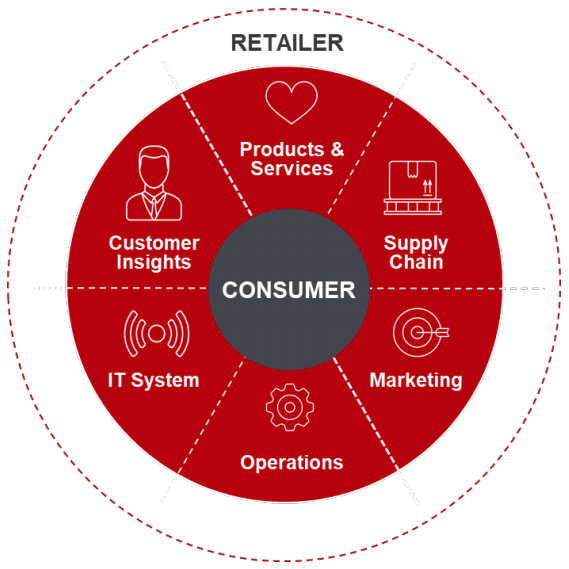 Source: Coresight Research[/caption]
New Retail seamlessly merges the online and offline worlds, powered by data. It leverages data for developing new products and services, optimizing the supply chain, crafting marketing messages, managing operations, running IT and e-commerce systems, and developing consumer insights. AI is the tool that links all of these functions.
Retailers Struggle To Integrate Their Data
Retailers have access to multiple sources of data, much of which is confined to silos, which host different, unconnected types of data, impeding retailers from seeing the big picture. Figure 3 illustrates the different types of data that retailers can benefit from, including internal data such as transactions and external data such as product reviews and social media postings. Much of this data is unstructured in form. Figure 3 also highlights the insights that retailers may be missing from the lack of data connections.
Figure 3. Retailers’ Data Sources and Potential Insights
[caption id="attachment_124572" align="aligncenter" width="720"]
Source: Coresight Research[/caption]
New Retail seamlessly merges the online and offline worlds, powered by data. It leverages data for developing new products and services, optimizing the supply chain, crafting marketing messages, managing operations, running IT and e-commerce systems, and developing consumer insights. AI is the tool that links all of these functions.
Retailers Struggle To Integrate Their Data
Retailers have access to multiple sources of data, much of which is confined to silos, which host different, unconnected types of data, impeding retailers from seeing the big picture. Figure 3 illustrates the different types of data that retailers can benefit from, including internal data such as transactions and external data such as product reviews and social media postings. Much of this data is unstructured in form. Figure 3 also highlights the insights that retailers may be missing from the lack of data connections.
Figure 3. Retailers’ Data Sources and Potential Insights
[caption id="attachment_124572" align="aligncenter" width="720"]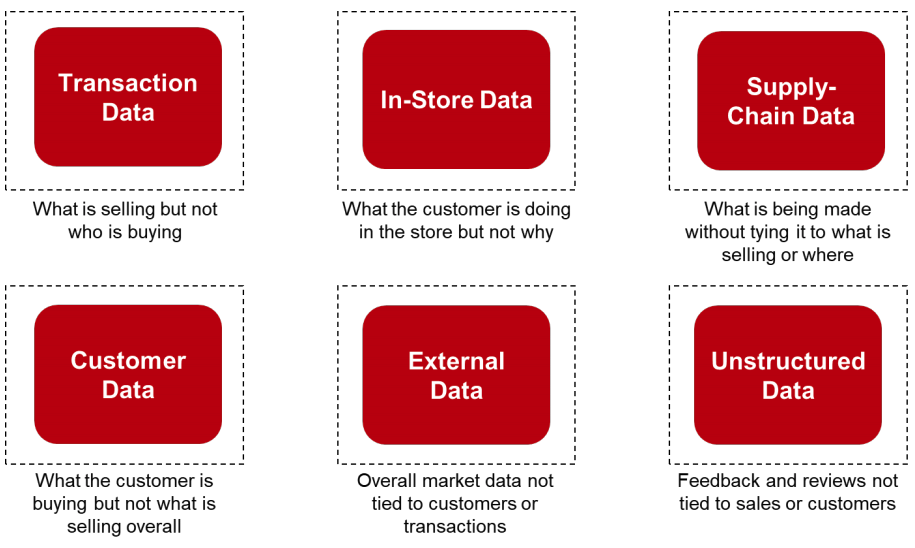 Source: Coresight Research[/caption]
Each type of data has its own unique limitations and only represents one piece of a retailer’s data puzzle:
Source: Coresight Research[/caption]
Each type of data has its own unique limitations and only represents one piece of a retailer’s data puzzle:
- Transaction data—This type of data shows what customers have already purchased, yet it contains no information on what they are interested in buying.
- In-Store Data—This data can offer a great deal of information on customer activity inside the store: including store areas visited by a consumer, their dwell time, and items they picked up but not purchased—for example, those left in a dressing room, as well as hot spots of dwell activity inside the store, yet retailers face the challenge of turning this raw data into the appropriate actionable insights. Although the potential to collect and leverage this data exists, not all retailers do so.
- Supply-Chain Data—This data represents the “what, when and where” of inventory, spanning from the manufacturer to the warehouse to the retailer, and sending demand and assortment information in the opposite direction. However, it does not reflect what consumers are actually purchasing and where.
- Customer Data—This data is very powerful, particularly when part of a customer relationship management platform, as it can be analyzed to predict what a customer is interested in buying, though it doesn’t give a full picture of aggregate demand.
- External Data—There is a wealth of data found in weather patterns and predictions, as well as calendar features such as upcoming holidays and local events, although it does not tie directly to what the consumer is actually buying.
- Unstructured Data—There is additional external data in unstructured text format, such as product reviews and social media posts, which can be mined to determine general trends and feedback on individual products.
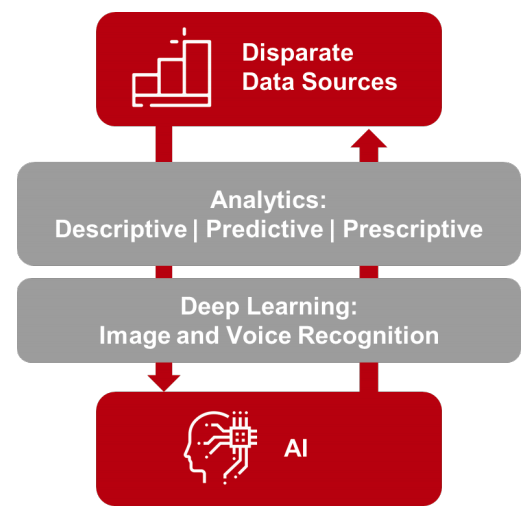 Source: Coresight Research[/caption]
Figure 4 highlights the main strengths of AI, including its applications as three types of ML analytics:
Source: Coresight Research[/caption]
Figure 4 highlights the main strengths of AI, including its applications as three types of ML analytics:
- Descriptive—What happened?
- Predictive—What will happen?
- Prescriptive—What should we do about it?
- What are retailers selling (the full cart)?
- Who is buying?
- Where are consumers buying?
- How much are consumers paying?
- What is driving consumers to buy?
- Are consumers happy with their purchases?
- Where does a retailer stand versus its competitors?
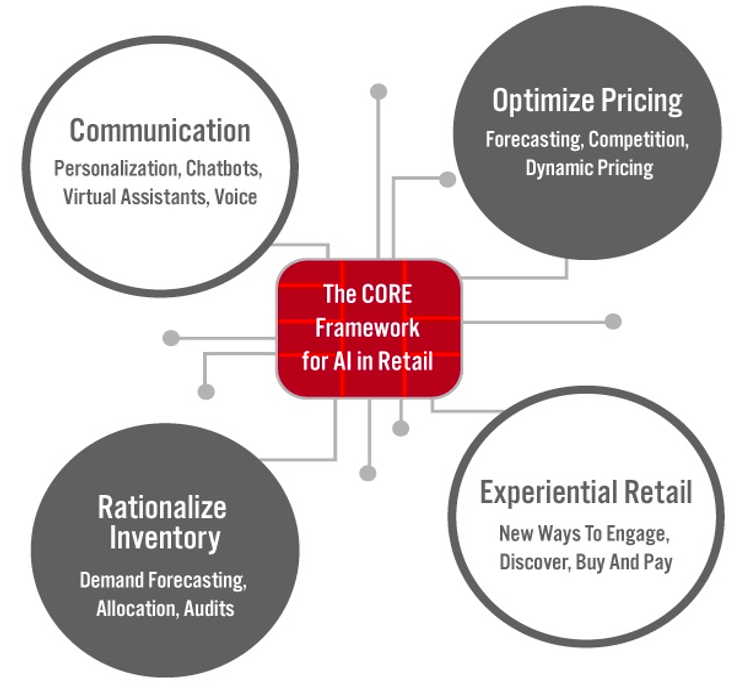 Source: Coresight Research[/caption]
We discuss examples of AI in retail through the lens of the CORE framework.
Communication
AI’s strengths in pattern recognition and finding connections in data have enabled new means of communication with computers, leading to the use of virtual assistants, chatbots, voice shopping and visual search functions in retail. AI-enabled means of communication are complementary: Natural language processing combined with speech recognition inside an intelligent assistant enables a device to converse and respond to voice input.
Source: Coresight Research[/caption]
We discuss examples of AI in retail through the lens of the CORE framework.
Communication
AI’s strengths in pattern recognition and finding connections in data have enabled new means of communication with computers, leading to the use of virtual assistants, chatbots, voice shopping and visual search functions in retail. AI-enabled means of communication are complementary: Natural language processing combined with speech recognition inside an intelligent assistant enables a device to converse and respond to voice input.
- Personalization—AI can leverage customer data to build a profile of the consumer, which can be used to craft personalized product recommendations, home page views, e-mails and other marketing materials.
- Chatbots—This technology enables retailers to offer an around-the-clock response to simple customer inquiries. The value of chatbots is multiplied when they are able to access customer information and purchase history. This enables them to respond to a simple but sophisticated inquiry such as, “I would like to return the blue sweater that I bought last month,” which requires an understanding of products, their characteristics and customer data.
- Virtual Assistants—Most major global technology companies have used AI to develop their own intelligent assistants, including Amazon’s Echo, Apple’s Siri, Microsoft’s Cortana and many others.
- Voice Shopping—This category leverages both intelligent-assistant and chatbot technology to enable consumers to receive a verbal shopping experience that is equivalent to online. It frees consumers from having to log on to their PCs or phones to shop, and also assists visually impaired consumers.
- Visual Search—This technology leverages the strength of AI in image recognition and also requires intelligence to understand types of products, colors and styles. The goal is the “holy grail” of retail, in which a consumer can take a photo of an item in a magazine, on a runway or on the street and be able to find and purchase that item, or a near-identical substitute.
Source: Company reports
Optimize Pricing The analytical functions of AI enable the technology to be used for forecasts and analyses, which can change dynamically.- Forecasting—ML offers several tools for creating forecast models including regressions, time series and binary models. These models can incorporate internal and external variables to forecast the variables necessary to manage a retailer’s business.
- Competition—AI’s ability to analyze structured and nonstructured data (such as text) can be applied to gain insights on competitor’s product information and pricing data, as well as a retailer’s own reviews and comments on social media to build profiles for developing new-product or pricing strategies.
- Dynamic Pricing—Similar to the above, the automation capabilities of AI enable systems to constantly monitor competitor’s prices and demand inputs, and set prices appropriately.
Source: Company reports
Rationalize Inventory ML excels in analysis and prediction, which makes it a useful tool in forecasting demand, product allocation and for conducting audits. Retailers can use these analytical methods to enhance supply chains and inventory management in the following ways:- Demand Forecasting—This method incorporates variables such as historical demand, consumer trends, weather forecasts, calendar events and other data to estimate product demand.
- Inventory Allocation—Based on a demand forecast and using the same variables, retailers can create forecasts of demand by store or geography, online or offline, to position inventory at the optimal location.
- Assortment Allocation—Again, based on a demand forecast and other data, retailers can determine the optimal quantities of products in a particular store or location.
- Order Management—Software can determine the most efficient route for processing an order, online or offline, or shipping from the store or warehouse or via drop-shipping.
- Warehouse Management—Demand and item-level forecasts can be used to determine the optimal placement of items within a warehouse to minimize fulfillment times.
Source: Company reports
Experiential Retail The concept of New Retail refers to a seamless fusion of online shopping, offline shopping and logistics. Retailers can use AI to make the online and offline shopping processes seem unified and seamless. Other technologies, such as artificial reality (AR) and virtual reality (VR) and livestreaming, can provide a virtual experience of visiting a physical store or mall. Retailers can leverage New Retail concepts in the following ways:- New Ways To Discover—Wayfinder robots can guide customers to products within the store, and employee tablets can leverage customer data to make relevant, personalized product recommendations.
- New Ways To Pay—Self-service and checkout terminals leverage customer and product data, which retailers can use to inform consumer profiles through AI analysis. Self-service payment and information points also provide self-reliant customers with a better experience by expediting their journey through the store. Computer vision ensures the accuracy of the self-checkout process.
- New Ways To Engage—Livestreaming combines Internet video with shopping to provide the thrill of live entertainment and scarce merchandise, broadcast from a store or a mall. Retailers can integrate AI into livestreaming to target content better and personalize livestream recommendations for consumers. Retailers can also utilize AI-powered virtual hosts for their livestreams to supplement their influencer-led sessions.
- Blend Online and Offline—In New Retail, a shopping journey can start online and end in the store, or vice versa. Consumers can shop online and pick up in store, or shop in a store and have their products delivered.
- Logistics—Automated warehouses and fulfillment centers leverage AI-powered computer vision technology and analytics to enable robots to navigate autonomously through the facilities. Moreover, retailers can leverage robotic vehicles, which use AI-fueled computer vision and analytics to guide autonomous delivery vehicles to deliver products to consumers.
Source: Company reports
What We Think
AI can be used to find actionable, unseen insights from retailers’ data that is otherwise largely trapped in silos. This can help retailers to improve consumer engagement, offer more relevant and personalized communication, run retail operations more efficiently, and remove friction in shopping, checkout and payment to offer a seamless New Retail experience. Implications for Brands/Retailers- Brands and retailers can benefit from the strengths of AI and data in engaging consumers more and communicating with them in a more personalized manner.
- Brands and retailers can also use AI and data to make their operations more efficient, particularly in terms of supply chains.
- Offering a seamless New Retail-inspired environment unlocks customers’ demand for shopping whenever and wherever they want, and also reduces points of friction that cause cart abandonment.
- Real estate firms can use data and AI to engage and communicate with consumers in a personalized manner.
- Real estate firms can also reconfigure their properties to support New Retail, including providing the technology infrastructure for seamless commerce and creating space for automated fulfillment.
- There are opportunities for technology vendors to develop AI and data tools throughout the value chain, from software infrastructure to tools and apps.
- There are many opportunities for developers to create new apps that build on this strong technology foundation in ways previously unimagined.
- Livestreaming remains in its infancy, and there are many opportunities to enhance the technology through AI, as well invent new ways to leverage it across retail.